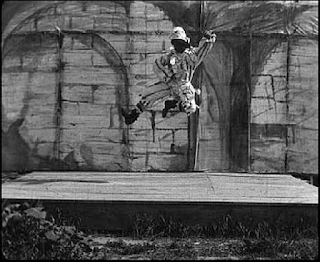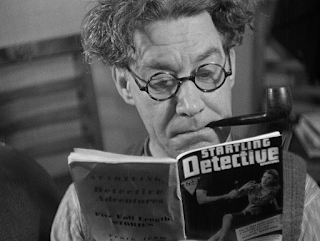Thus, it can be seen that even the most unworldly peasant
can make a valuable contribution to the labour movement… As with Michael
Powell, Boris Barnet was not phased by the strictures of propaganda and weaves
his way around the need to deliver this core messaging whilst still providing entertainment. This film is funny, inventive and
superbly edited with the actors giving sardonic and engaging
performances that make light of the script ultimately conspired by five different writers.
The original script dated back to Lenin’s era and a call for the common comrade
to be ready to participate in democratic process whilst Stalin’s era was driven
by a lengthening process of pulling more from the country to work in the city. Barnet meets both these objectives with wit and irreverent undercurrents which
pull in the viewer in more subtly and completely than more earnest polemic.
I’m second-guessing historically but by the end of the
film I was all for marching my support for Parasha Pitunova (Vera Maretskaya)
as elected deputy of the Moscow maids' Trade Union.
In addition to some wonderful location shots of Moscow - Yevgeni Alekseyev’s cinematography is a wonder – there’s also a fantastic set showing the flights of stairs inside the tenement on Trubaya, like Dante’s Hell each level denoting a different level of position and snobbery with some of the worst at the lowest levels. It’s a superb way to illustrate the neighbourly interactions as well as the building’s “society” and, in a hectic start, Alekseyev’s camera pulls in and out as we witness the chaos – two men chopping wood on one landing, pausing to let a disabled child squeeze past, whilst others squabble over laundry as another day in civilisation begins.
 |
| Inside the house on Trubnaya |
Barnet plays with expectations and form throughout
notably when Parasha is chasing a duck in the streets and grabs it just as a
tram moves at speed towards her, the driver leaps out and is suspended –
freeze-framed - in mid-air as the title card reads: “… but wait, we forgot
to tell you how the duck ended up in Moscow.” All this after some ten
minutes of set up including rapid cuts, reversed film, montage (natch) and the
goings on in the staircase set. This was Barnet’s fourth film but it’s his Revolver
in terms of pushing the boundaries.
But wait, I forgot to tell you how I ended up in
Kennington…
This was my first visit to the Cinema Museum since March
2020 and it was a delight to see the Kennington Bioscope back up and running.
The KB carried on through the pandemic with KBTV on YouTube and whilst the path
to the old place is all still familiar, what a time we’ve had. The old team was
back together in the flesh and as star of stage and small screen, KBTV’s MC Michelle
Facey introduced and John Sweeney warmed up for the first films… we were about
to party like it’s 2019.
 |
| Still Dot Moving |
Our first film was Still Dot Moving, a new silent short made by print-maker
Julia Vogl which was a mesmerising sequence of original prints superimposed and
almost glowing with a vibrant rhythm as John Sweeney overlayed his musical
response. This was startling and unlike anything you might expect from the
context but it was a fine way to return to the screen. John Sweeney’s
accompaniment was as intricate and mesmeric as Julia’s images and this was the
perfect example of the continuing possibilities of film and live music. 1
John then introduced us to the ground-breaking Russian dancer and film maker Alexander Shiryaev, who not only founded character dance in Russian ballet at the Mariinsky Theatre but also (probably) invented stop motion animation. Shiryaev’s interests were strictly in support of his work – helping to show his dancers his intended movements and choreography – and were only discovered in the 1990s. As John said, his ability to capture movement using these techniques was remarkable and the three films screened, one paper animation, another stop-motion and a third showing Shiryaev performing a Cossack dance with his wife, dancer Natalia Matveeva, were captivating especially when aided by such a practiced dance accompaniment!
 |
| Alexander Shiryaev |
A Lupino Lane short comedy followed, Goodnight Nurse (1929) a new scan of 35mm nitrate and one of a number
restored by the KB’s David Wyatt and Dave Glass following a Kickstarter
campaign. It showcased the Brit’s speed of movement and athleticism which
matched those who’d gone over to Hollywood before if not necessarily in terms
of originality, then certainly flexibility and comedy!
Accompaniment for this was provided by the sprightly hands
of Radio’s Colin Sell who’s worked with more than a few old jokers in his time
and was the perfect comedy accomplice for Ida Lupino’s Uncle, the man who used to
dance The Lambeth Walk. The Lupino Lane restorations are now available on DVD
and you can purchase them from Amazon soon.2
Yes, but what about the duck?
After Boris stops his film with the endangered duck, the
tram driver is unfrozen and jumps backwards into his reversing tram and we’re
run back to scenes of Parasha about to depart from her village where she has
been staying with her aunt. She’s off to stay with her Uncle Fedya (Aleksandr
Gromov) in Moscow but, just as she climbs on board with a wicker bag containing
food and the present of a white duck (uncredited, sadly) her train departs just
after one arrives with Fedya on it.
Cue dreamy views of Parasha’s train slicing through trees
and fields on route to Moscow and then her disorientation in finding that Fedya
is not where he’s supposed to be. She wanders all night ending up with the
above Duck Distress before, as chance would have it, being spotted by someone
she knows.
 |
| Semyon in his motor |
In the first ten minutes, Barnet has already shown us Semyon
Byvalov a young chauffeur (Vladimir Batalov) preparing his car and then driving
through Moscow with his sweetheart Marisha-maid (Anel Sudakevich). The
narrative threads now intersect as he picks up his old friend and takes her to Trubaya.
Here she gets work as a maid with the very odd couple of Mr. Golikov (Vladimir
Fogel), a hairdresser, and his slovenly wife (Yelena Tyapkina) who seems to
have perfected the art of lounging. Mrs. Golikov refuses to allow a union
member to be their maid – probably more on economic than political grounds – so
the newly arrived innocent is perfect for her purposes.
The Golikov’s are key characters, especially the
hairdresser. He is hyperactive and ridiculous, washing their plates in the
absence of a maid and after drying them flinging them across the room to smash.
She is full of undeserved airs and graces… the sort of bourgeoise the
Revolution was supposed to galvanise and re-purpose.
 |
| Another interesting sequence with Vera Maretskaya followed by (hand-held) camera through a crowd |
But Parasha is of good intention and only sees other’s
better motives. She is befriended by Fenya (Ada Vojtsik) who is politically
active and takes her to union meetings. The workers arrange a play about the
French Revolution which completely bewitches Parasha who, having not seen
theatre before, attacks Golikov on stage as his character is assassinates Semyon’s…
this wins her the love and support of the audience but Golikov immediately
sacks her.
Our irritable boss has reckoned without the impact his
young maid has created and soon he learns that she has been elected to the post
of deputy by the maids’ trade union. This immediately elevates the standing of
her former employers and Mrs Golikov is not alone in being keen to to ride this particular tide
yet can her husband control himself for long enough to act in his and, more importantly, others' best
 |
| Parasha on the march |
The House on Trubnaya is very clever slapstick
mixed with social observation and the required political messaging: if all
bosses are as venal and self-serving as the Golikov’s – even over a decade on
from the Revolution – then workers need to join unions to support themselves
and others. It never lectures just wends its peculiar way scoring laughs over
political points and that’s exactly why it’s so watchable now.
Cyrus Gabrysch accompanied in style and relished this
return to the silent film “club” he helped found! Welcome home Mr Gabrysch and
everyone else involved in this wonderful collective!
1. More about Julia Vogl's work on her website and her Instagram.
2. More details of the Lupino Lane project on their Kickstarter page.
 |
| No ducks were harmed in the writing of this post. |























































+colour.png)





